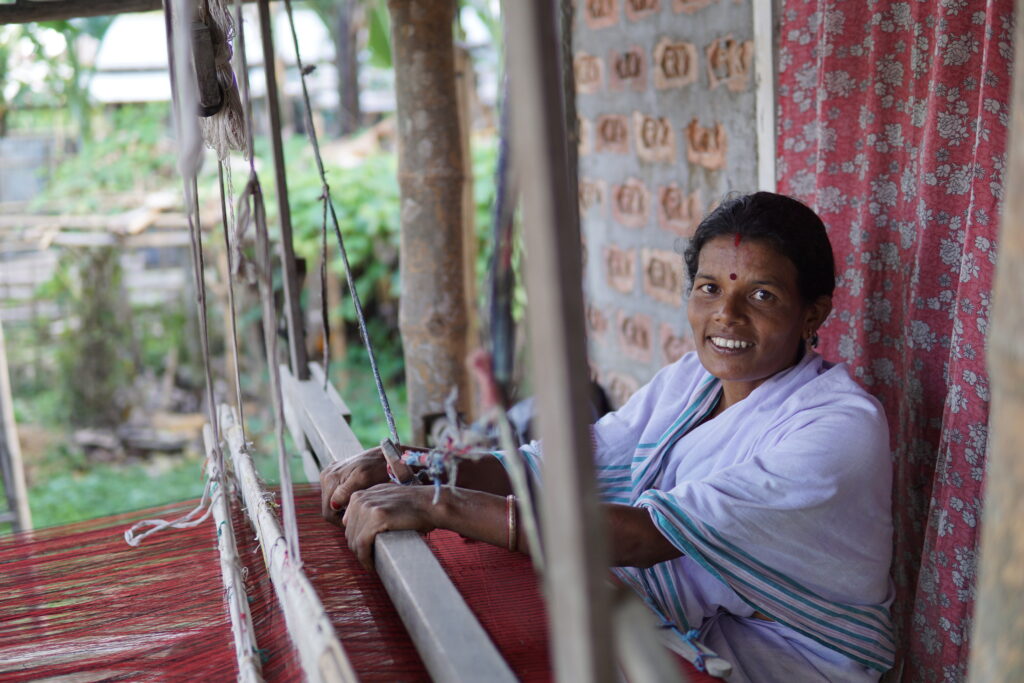Ms. Kausalya Nayak | Client of MicroVest portfolio company, Annapurna
Kausalya Nayak resides in Rajpur village in northern India. After losing her husband seven years ago, she decided to use her training in weaving handloom clothes, which she received from the government, to start a small saree-making business. She initially applied for a Samarth loan from Annapurna and used it to buy raw materials for her business.

Kausalya’s saree business gave her the ability to financially support her two sons in their education, manage household needs, and provide for the medical needs of her ailing mother-in-law. Besides the economic benefit, her business has increased Kausalya’s reputation in society and she has become an inspiration to others in her village.
Now, Kausalya’s eldest son is pursuing his graduate studies and her younger son is studying in the 10th standard grade. Both sons help their mother run her business.
For her second loan cycle, Kausalya received a loan of INR 40,000 ($542) and was able to increase her raw material inventory, which spurred production as well. She currently makes around 20 sarees a month and sells them to the retailer who collects them from her house. Kausalya makes between INR 700 ($9) to INR 800 ($11) for each saree sold, depending on the complexity of design and cloth quality. She hopes to buy a power loom that can further improve the speed and scale of production. She recently received a INR 70,000 ($949) loan which she plans to invest in buying a better machine. Her loyalty to Annapurna and good repayment history has made her eligible for Annapurna’s Pratham Loan, a loan designed for Privileged loyal customers.
Kausalya’s Lender: Annapurna (India)
In 2009, People’s Forum (PF), an India-based non-government organization (NGO) established Mission Annapurna to support the development and welfare of India’s underserved communities. To cater to a larger customer base, Annapurna Microfinance was established a year later with a mission to bring underserved rural communities, especially women, into the social and economic mainstream. Annapurna provides financial products to customers in districts and regions that are vastly underserved by banks and other financial institutions.
Today, Annapurna is one of India’s leading microfinance institutions (NBFC-MFI) with products ranging from group loans to project-specific micro loans and MSME loans to small business owners..
From 2015 when MicroVest disbursed its first loan to Annapurna, the company has grown its loan portfolio from almost $88 million to more than $500 million. Due to regular monitoring and follow up on loan proceeds, including a mandate that necessitates financial literacy training for its borrowers, re-payment rates on the company’s collateral-free loans are more than 99%. By accessing fair financial services and other forms of support, Annapurna hopes that its clients can strengthen their entrepreneurial skills and move closer toward their business goals.
Annapurna emphasizes social equity in the workplace alongside financial performance and does so through a Social Performance Management Department. The Department has many gender initiatives that address inclusiveness and encourage greater female participation in its workforce, which are outlined in its dedicated Gender Sensitive Code of Conduct. For example, Annapurna incentivizes female field and branch employment through subsidized two wheeler loans for female employees and a relaxing placement location distance requirement from home villages for women (men: 200km; women: 50-100km). At least one woman is required to be present for all employment interview panels, and the employee complaint committee has 50% female representation. Further, Annapurna prides itself in its commitment to various corporate social responsibility (CSR) activities, which have allowed it to contribute meaningfully to advancements in healthcare and water/sanitation.
The RFI profiled here is for educational purposes only and may not represent all of the portfolio holdings. It should not be assumed that investments in the RFI identified and discussed were or will be profitable. The RFIs profiled were selected based on their financial inclusion and impact with no reference to amount of profits or losses, realized or unrealized.